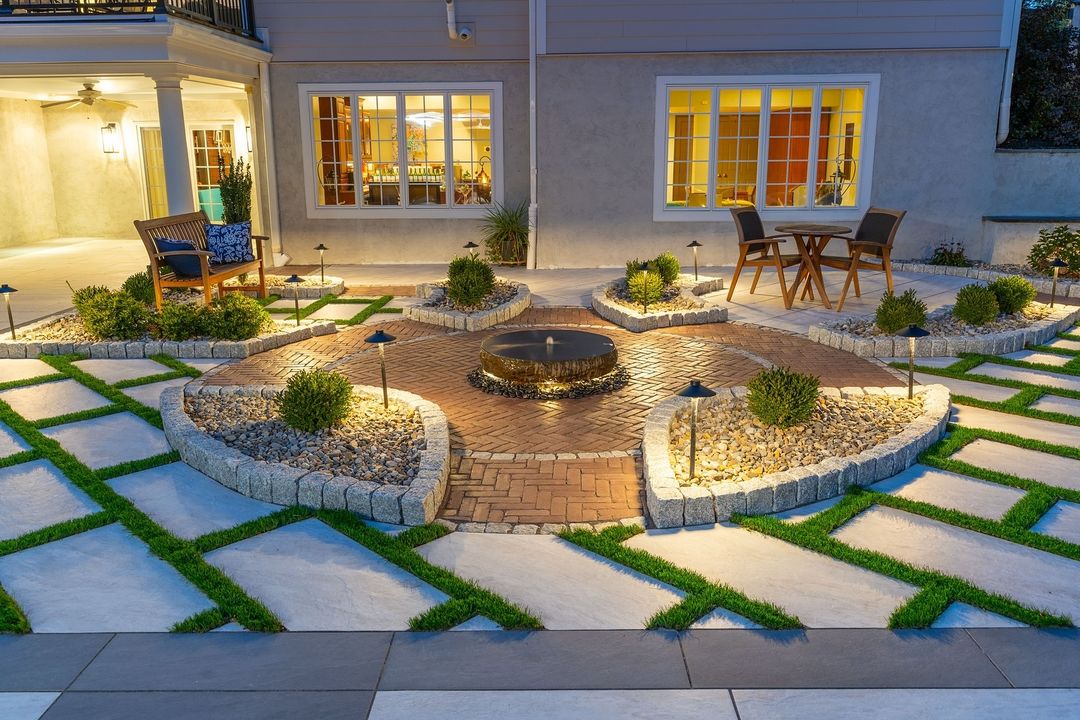Knowing how to install pavers can make a lot of difference. These days, DIY installation is common among homeowners. If done right, the DIY paver installation can offer you a stunning and durable outdoor area. However, not every homeowner has an exact idea about the DIY paver installation. One can find different types of pavers to install, but each paver type has slightly different requirements. In this blog post, we will guide you through DIY paver installation methods and anything in between. Continue reading the following.
Tools & Materials Required To Install Pavers
This is a crucial step in how to Install Pavers. These tools will make the DIY process much easier and quicker. These include:
Tools:
- Measuring tape
- stakes
- string line
- shovel
- Rake
- hand tamper or plate compactor
- Level
- rubber mallet
- Broom
- garden hose
Materials:
- Pavers
- gravel (crushed stone)
- coarse sand (concrete sand)
- landscape fabric (optional)
- edge restraints
- joint sand (polymeric sand recommended)
How to Install Pavers (10-Step Guide)
Installing pavers shouldn’t be hard. Here is how you can do it.
Plan & Mark the Area To Install Pavers
Step 1 of How to Install Pavers
- Measure and outline the desired area by using the string and stakes.
- Make sure that the layout is square by checking diagonal measurements.
- Don’t forget about the slope. Keep it about 1 inch every 4–8 feet away from structures for proper drainage.
Dig the Site
Step 2 of How to Install Pavers
- Dig down 6 to 8 inches according to the base, sand, and paver thickness.
- Before digging, you will need to calculate the total depth of depth required for paving.
- Add up the inches you need for the base (4 to 6 inches), sand bedding (1 inch), and paver thickness.
- You’ll know how deep you have to dig. Using a compacting machine, dig out to the indicated depth, level, and compact the ground.
- The temporary border should be set at the appropriate height and slope after excavation is complete for rectangular areas.
- Remove all grass, roots, and debris.
- Compact the soil to create a stable sub-base.
Install Edge Restraints
Step 3 of How to Install Pavers
- Now, place the edge restraints along the area of installation, as this will prevent the shape and paver movement over time.
- Use spikes and stakes to keep it secured according to the manufacturer’s instructions.
Add the Gravel Base
Step 4 of How to Install Pavers
- Lay a 4-6 inch layer of crushed stone or gravel.
- Evenly spread and compact thoroughly using a temper or plate compactor.
- Make sure the base maintains the slope you intended.
Add and Level the Sand Layer
Step 5 of How to Install Pavers
- Next, you will need to spread a 1-inch layer of coarse sand over the compacted gravel.
- Level the sand evenly by using the screed boards or pipes
- Do not walk over the surface once it is level to keep it even.
Lay the Pavers
Step 6 of How to Install Pavers:
- Now, start from the corner and lay the pavers according to your desired pattern.
- Place them directly and straight, do not slide them.
- Maintain consistent gaps (about 1/8 inch) between pavers.
- Use a rubber mallet to tap pavers into place, ensuring they are level.
Cut Pavers as Needed
Step 7 of How to Install Pavers:
- To cut the pavers, you can use a masonry saw or chisel so it will fit the edges or curves.
- Always wear safety gear when cutting pavers.
Fill Joints with Sand
Step 8 of How to Install Pavers:
- Spread joint sand over the surface and sweep it into the gaps between pavers.
- For best results, use polymeric sand, which hardens when moistened, reducing weed growth.
Compact the Pavers
Step 9 of How to Install Pavers:
- After filling joints, compact the entire area to set the pavers into the sand base.
- This also helps the sand settle into the joints.
Final Touches
Step 10 of How to Install Pavers:
- Sweep off excess sand.
- Lightly mist the area with water to activate polymeric sand, if used.
- Allow the area to dry and set as per the manufacturer’s instructions.

Different Types Of Pavers And Their Installation
Before you opt for DIY installation, you should understand the types of pavers that will suit the exterior. Select the one that you believe is best for your project and proceed accordingly. The different types of pavers include:
Natural Stone Pavers
These pavers come from natural stones like marble, travertine, or sandstone. They give a very earthy and elegant look. You can make the outside space look more sophisticated with them. Natural stone pavers have a great, earthy, and elegant appearance.
Porcelain Pavers
These are widely liked for outdoor usage. They are crafted from dense clay material. Concerns about stains and scratches become unnecessary with the use of porcelain pavers. These paving stones can offer you a contemporary style and simple maintenance solutions for outdoor spaces.
With a solid understanding of each type, let’s move into the installation process for each.
Concrete Pavers
Concrete Pavers are strong and available in varying shapes, colors, and sizes. These pavers provide an affordable choice for most exterior projects and are simple, to begin with for installation by yourself.
Brick Pavers
Such types of pavers show great strength and have a long life, making them optimal for outdoor usage. They possess an everlasting appeal due to their classic design and warm colors. However, they need consistent upkeep. These pavers are sturdy and can withstand heavy foot traffic.
How To Install Natural Stone Pavers?
They come at a comparatively high price so installing through DIY requires technical knowledge to avoid any damage. Here is how you can install them:

Plan the Design and Layout
Step 1 of how to install natural stone pavers:
- Measure the area and outline it with the stakes and strings. Also, plan a well-suited layout to create a stunning surface.
Excavate and Compact the Soil
Step 2 of how to install natural stone pavers:
- Dig the selected surface about 8 inches. This will create a space for base layers, which will be adjusted according to the paver thickness.
- Compact the soil thoroughly.
Add the Gravel Base
Step 3 of how to install natural stone pavers:
- Spread a 4-inch thick layer of crushed gravel and firmly compact it.

Add a Sand Bedding Layer
Step 4 of how to install natural stone pavers:
- Place a layer of coarse sand around 1-2 inches over the gravel to level it carefully.
Lay the Stone Pavers
Step 5 of how to install natural stone pavers:
- Set each natural stone paver into place and adjust them to fit together without large gaps.
- Tap them gently with a rubber mallet to ensure stability.

Filling the Gaps
Step 6 of how to install natural stone pavers:
- Fill the gaps with the polymeric sand to fill the gaps between the pavers. It will harden the pavers and prevent weed growth.
- Brush off any excess sand from the surface and mist it regularly. A gentle water spray will activate the polymer clay.
Seal (Optional)
Step 7 of how to install natural stone pavers:
- Natural stone like marble, has a porous surface. Sealing them regularly will increase their durability and lifespan. Sealing can also make them scratch-proof proof and cleaning becomes much more convenient.
Read also our guide on how to install marble
How To Install Porcelain Pavers
Installing porcelain pavers is rather easy for beginner DIYers. Here is what you can do!
Prepare the Area
Step 1 of how to install porcelain pavers:
- Work on the playout by marking the site with chalk and string.
Excavate the Area
Step 2 of how to install porcelain pavers:
- You will need to dig down about 4-6 inches to create a base.
Install the Base Layer
Step 3 of how to install porcelain pavers:
- A layer of crushed gravel, which should be 4 inches thick is required. Compact it completely after that.
- Apply a 1-inch-thick layer of sand over the gravel and level it.

Lay the Porcelain Pavers
Step 4 of how to install porcelain pavers:
- Place each porcelain paver carefully. Make sure to leave no gap between the pavers by aligning them with the edges.
- Gently place them down on a rubber mat to keep them firmly in their place.
Fill the Joints
Step 5 of how to install porcelain pavers:
- For porcelain pavers, joint sand or flexible grout can be used to fill the gaps. This will prevent any movement and create a clean look.
Seal (Optional)
Step 6 of how to install porcelain pavers:
- Porcelain pavers are durable enough that they don’t require any sealing. If you want to you can apply a coat and it will enhance the overall durability and lifespan of porcelain.
Read also our complete guide on porcelain paver installation
How To Install Concrete Pavers?
Concrete pavers are versatile in application and easy to install. Here’s a step-by-step guide to installing them yourself:
Plan and Measure
Step 1 of how to install concrete pavers:
- First, you should select the area where you want to install these pavers. Measure it correctly and use chalk and stakes to outline it.

Excavate and Level
Step 2 of how to install concrete pavers:
- Excavate the ground approximately 6-8 inches depth to allow space for the paver and its base layers.
- Level the soil neatly to create a solid foundation.
Add the Base Layers
Step 3 of how to install concrete pavers:
- A layer of crushed stone or gravel is enough to spread on the base which should create about 4-6 inches of thickness. Compact it using a tamper or plate compactor.
- Place a layer of coarse sand (1 inch) on top of the gravel base. Use a screed board to level it evenly.

Lay the Pavers
Step 4 of how to install concrete pavers:
- Once the base layer is done, lay the concrete pavers in your desired pattern. Always start working from a corner and work your way out.
- Tightly place the pavers together and adjust them as much as required.
Fill the Joints
Step 5 of how to install concrete pavers:
- Spread the joint on the paved surface you laid. You should fill the spaces between the pavers with the broom.
- Gently compact the pavers with a plate compactor to settle them into the sand.

Sealing Concrete Pavers
Step 6 of how to install concrete pavers:
- Concrete pavers are durable but if you want to enhance their performance and longevity then opt for sealing. Sealing will protect it from cracks and outdoor elements. Make sure to select the right type of sealant for better experience.
How To Install Brick Pavers
Installing brick pavers on your driveway and walkways is way easier. Here is what you can do!
Plan and Prepare the Site
Step 1 of how to install brick pavers:
- Mark the installation area with stakes and strings, and ensure the layout accommodates any drainage needs.

Excavate and Prepare the Base
Step 2 of how to install brick pavers:
- Dig out the installation area to a depth of 6-8 inches.
- Compact the soil and lay a geotextile fabric to prevent weed growth.
Add Gravel and Sand Layers
Step 3 of how to install brick pavers:
- Spread a 4-inch layer of gravel as a base and compact it.
- Follow with a 1-inch layer of sand, leveling it with a screed.

Lay the Bricks
Step 4 of how to install brick pavers:
- Lay each brick into your chosen pattern. Make sure to maintain a tight space between them to create a strong structure.
- Tap gently each brick with the rubber mallet to put it into place.
Filling Joints with Sand
Step 5 of how to install brick pavers:
- Sweep fine sand into the joints, repeating the process until they are full.
- Compact the pavers to lock them into place and add additional sand if necessary.

Seal The Surface
Step 6 of how to install brick pavers:
- A sealant can enhance the color of the bricks and add a layer of protection against stains.
DIY Vs Professional Paver Installation
DIY installation is one of the latest trends among homeowners. They want to install the pavers by themselves but it is not everyone’s cup of tea. While installing on small areas such as a small deck or patio can be an easy task, large areas require more time and skillful hands. This is where professional paver installers can be helpful. Here’s a comparison table that highlights the key differences between DIY and Professional Paver Installation:
| Aspect | DIY Paver Installation | Professional Paver Installation |
| Cost | Lower initial cost, mainly materials and equipment rental | Higher initial cost due to labor fees and expertise |
| Required Time | It can be time-consuming, especially for beginners | Typically faster with an experienced team |
| Skill Level | Requires basic to intermediate skills and patience | Managed by skilled professionals with expertise |
| Tools & Equipment | Basic tools needed may require the rental of compactors | Access to professional-grade tools and machinery |
| Quality of Finish | The finish can vary; potential for uneven or misaligned pavers | High-quality, even, and polished finish |
| Durability | This may lead to potential issues like shifting or settling if not done properly | High durability and fewer issues due to correct techniques |
| Potential Challenges | Learning curve, especially with layout and leveling | Minimal challenges, as handled by experienced installers |
| Flexibility in Design | Flexible but limited by DIY skills and experience | A wider range of design options and patterns |
| Maintenance Needs | Higher likelihood of maintenance due to potential mistakes | Lower maintenance requirements, especially initially |
| Long-Term Investment | May save money short term, but can lead to costly repairs | Higher upfront cost, likely lower cost over time |
| Warranty | Typically no warranty on DIY work | Often includes a warranty on labor and sometimes materials |
Maintenance Tips for Long-Lasting Pavers
Whether you use a DIY approach or professional paver installation, regular maintenance for pavers is important. This is the only way to improve the lifespan and beauty of the pavers. Some of the crucial tips to maintain the pavers include:
Regular Sweeping:
This is one of the most important parts of maintaining the pavers. Dirt and dust can accumulate on outdoor pavers. They can make the pavers look dull and even cause scratches over time on natural pavers. Regular seeping with a soft-bristled broom can prevent dirt accumulation.
Read also our guide on Natural stone cleaning
Reapply Sand and Sealer:
Regularly check the condition of polymeric sand in the joint. It will dry out over time. Also, regular pavers sealing every 2,3 years (depending on the exposure to the outdoor elements) can help the pavers to look in pristine condition. Importa
Check For Shift And Cracks
Shifting and cracks in pavers are a common occurrence over time. Even the most durable one like porcelain may show signs of wear and tear after a time. So keep an eye on the pavers’ layout and observe any abnormalities.

Conclusion
Pavers are an important part of any home’s exterior. They improve the overall functionality and aesthetics of the area. However, proper installation is crucial for the best results. DIY methods of paver installation are a good idea if you have technical knowledge and access to the right equipment.DIY installation can be a rewarding experience if done properly. If you are not experienced enough with this then consider hiring professional paver installers for the best results. They know how to get things done.







